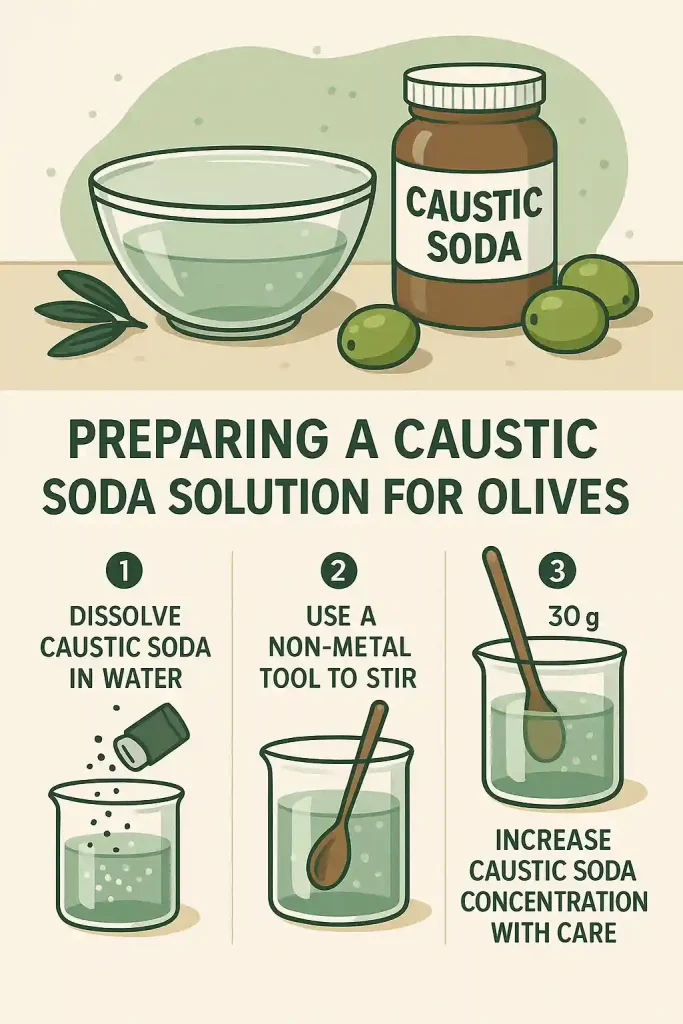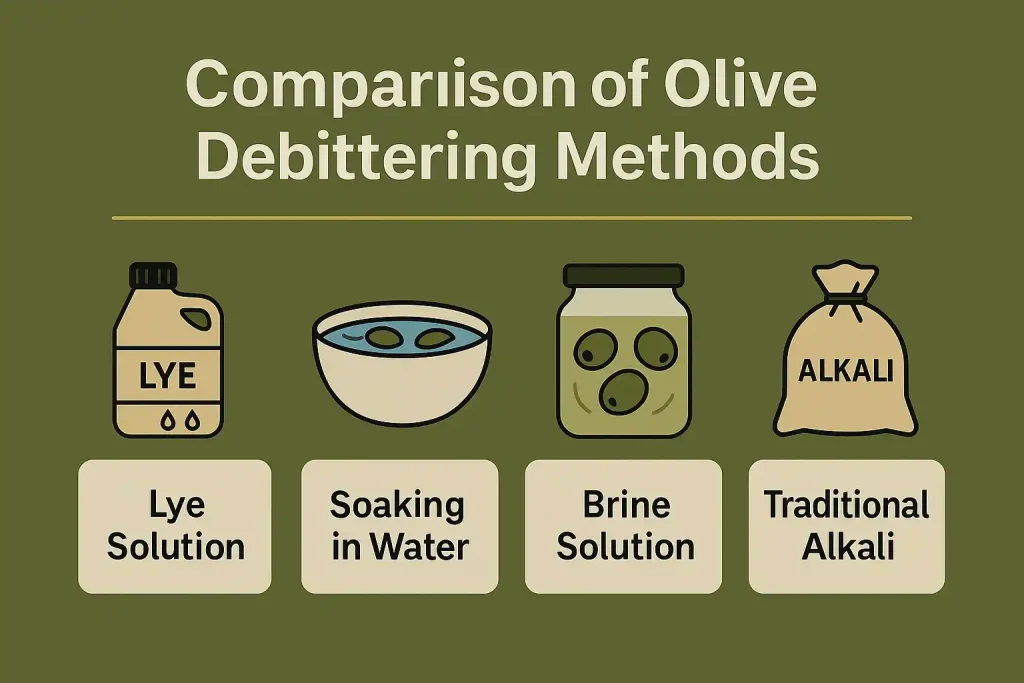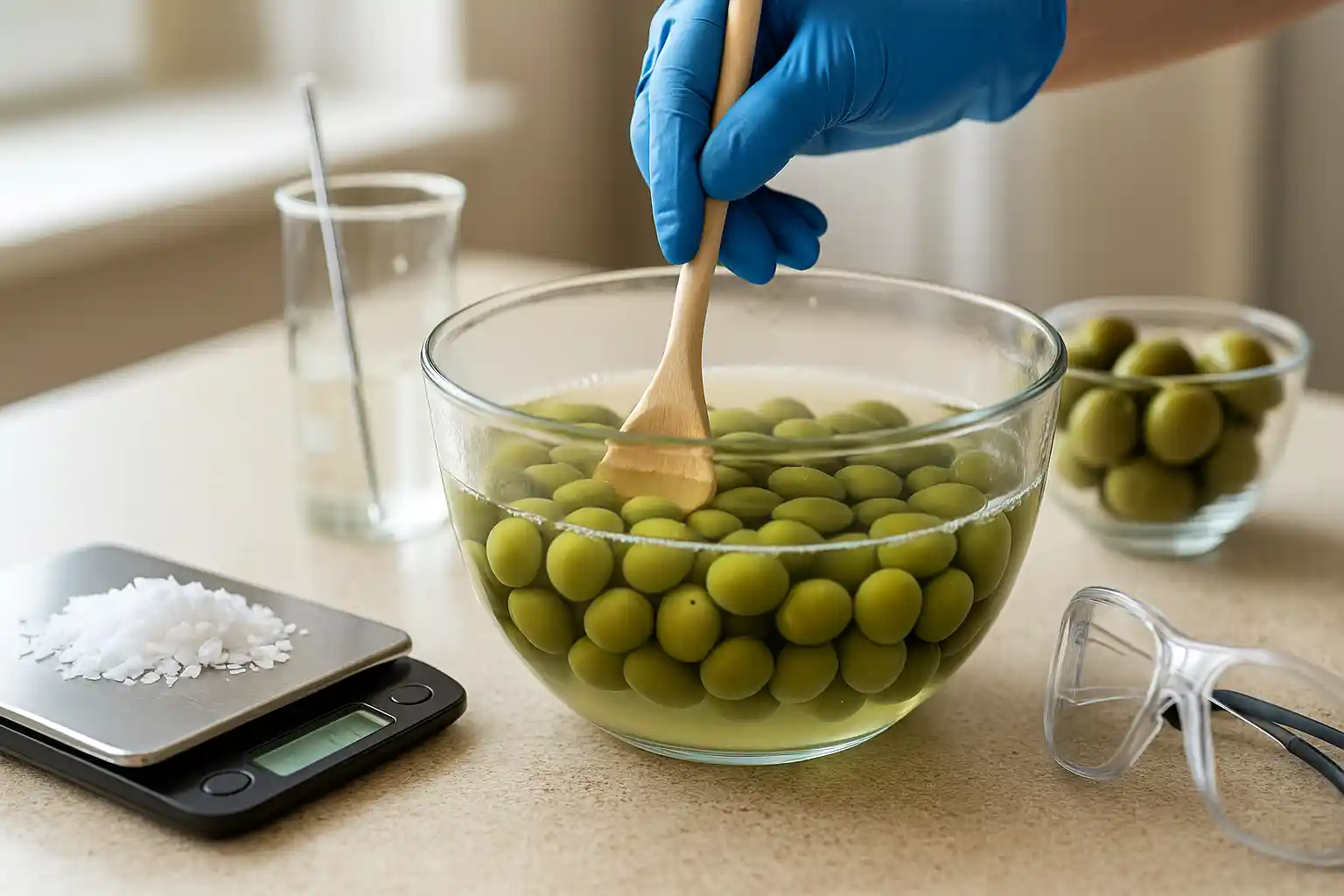Olives are one of the world’s most valued fruits, central to Mediterranean and Iranian cuisine for centuries. But in their raw state, freshly harvested olives are extremely bitter due to a natural compound called oleuropein. Without proper treatment, these olives are inedible.
The most efficient and trusted method for removing this bitterness is the use of caustic soda flakes (food-grade sodium hydroxide). This solution breaks down oleuropein, transforming raw, bitter fruit into crisp, delicious olives with a perfect texture.
Today, advanced food science has elevated this traditional process. By using high-purity, food-grade caustic soda flakes from caustic-soda.ir, producers and home users alike can ensure their olives are not only tasty, but also completely safe for consumption.
For global background on olive cultivation and processing, see the International Olive Council, the leading authority in this field.
This guide provides a complete, step-by-step reference to olive debittering:
- How to prepare olives at home
- Professional methods used in industrial production
- Safety standards and best practices
- Common mistakes to avoid
With the right product, careful technique, and attention to detail, you can transform raw olives into a gourmet delicacy—whether for family use or large-scale production.
What Are Caustic Soda Flakes?
Caustic soda flakes, chemically known as sodium hydroxide (NaOH), are a strong alkaline compound widely used in food processing. In the olive industry, they serve as the most effective solution for breaking down oleuropein, the natural bitter element in raw olives. When carefully measured and applied, they transform olives from inedible to perfectly balanced in taste and texture.
This method has been refined over decades in Mediterranean and Middle Eastern regions. While traditional approaches once relied on wood ash or long water soaks, caustic soda provides a faster, more reliable, and consistent outcome.
Why Purity Matters
Not all caustic soda is safe for food use. Food-grade caustic soda flakes undergo strict quality control to ensure they are free from harmful impurities. Industrial-grade sodium hydroxide, on the other hand, may contain contaminants that make it unsafe for consumption. For olive processing, always choose food-grade material to guarantee safety and high-quality results.
International Food Standards
The use of sodium hydroxide in food processing is recognized globally. According to guidelines from the Food and Agriculture Organization (FAO), food additives and processing aids must meet strict purity and safety requirements. Food-grade caustic soda aligns with these standards, making it a trusted choice for professional olive preparation worldwide.
Safety First
While caustic soda is highly effective, it is also a corrosive substance. Safe handling is essential:
- Wear protective gloves and goggles
- Work in a well-ventilated area
- Avoid contact with skin and eyes
- Rinse olives thoroughly after treatment to remove all traces of the solution
These precautions ensure that the final product is safe, flavorful, and free from chemical residues.

Step-by-Step Home Method for Olive Debittering
Processing olives at home with food-grade caustic soda flakes is both simple and rewarding. With careful preparation, you can create gourmet-quality olives in your own kitchen. Below is a complete step-by-step guide designed for home users.
Step 1: Selecting and Preparing the Olives
Choose firm, healthy olives. Both green and black varieties can be processed, but note that green olives contain higher levels of oleuropein and therefore require a longer soaking time.
- Wash the olives thoroughly with cold water.
- Remove soil, leaves, or debris.
- Discard any damaged or bruised fruit to avoid uneven results.
Step 2: Preparing the Caustic Soda Solution
For every kilogram of olives, dissolve 20–25 grams of food-grade caustic soda flakes in one liter of cold water.
- Always use plastic or glass containers since caustic soda reacts with metals.
- Stir with a non-metallic utensil (such as a wooden spoon) until fully dissolved.
- For very bitter green olives, the concentration may be increased up to 30 g/L, but handle with caution.
⚠️ Important Safety Tip: Wear rubber gloves, protective goggles, and long sleeves when preparing the solution. Avoid inhaling dust or vapors.
Step 3: Soaking the Olives
Submerge the olives fully in the solution. A small plate can be used to keep them below the liquid surface.
- Green olives: 10–12 hours
- Black olives: 8–10 hours
Check the olives every 2–3 hours. If they become too soft or pale, stop the process immediately.
Step 4: Washing and Removing Residues
This step is critical for safety and taste. After soaking:
- Drain the solution completely.
- Rinse the olives several times with cold water.
- Soak them in fresh cold water for 2–3 days, changing the water twice daily.
This guarantees that no chemical traces remain and that the olives are crisp, safe, and delicious.
Step 5: Flavoring and Storing
After thorough washing, the olives are ready for seasoning:
- Brined olives: Place in a salt solution (70 g of salt per liter of water).
- Marinated olives: Add flavors such as garlic, lemon, chili, or herbs.
- Traditional seasoned style: Combine with pomegranate paste, walnuts, and aromatic greens for a rich, local delicacy.
Store the olives in clean glass jars and keep them in a refrigerator or a cool, dry place.
For best results, always start with smaller quantities during your first attempt. Once you are comfortable with the process, scale up to larger batches.
Industrial-Scale Olive Processing with Caustic Soda Flakes
While home preparation offers a traditional and personal touch, industrial-scale olive processing requires advanced systems designed for efficiency, safety, and consistency. Food-grade caustic soda flakes remain the foundation of this process, but at larger volumes, specialized equipment ensures precision and quality control.
Large-Scale Soaking Systems
In industrial facilities, olives are typically treated in large stainless-steel or food-grade polyethylene tanks. Each tank is equipped with:
- Automated mixing systems to ensure uniform solution strength
- Controlled temperature and pH monitoring
- Safety valves and overflow systems
By using automated dosing systems, the exact concentration of caustic soda can be measured and adjusted for each batch.
Automated Washing and Neutralization
Once the debittering stage is complete, olives are transferred into multi-stage washing systems. These often include:
- High-volume water sprays
- Automated drainage and refill systems
- pH sensors that confirm neutrality before the next step
This automation ensures that every olive is completely free from chemical residue, a requirement for food safety compliance.
Industrial Flavoring and Preservation
After debittering and washing, olives enter the flavoring stage. Depending on the target market:
- Standard brined olives are packed in large vats with carefully balanced saltwater.
- Marinated olives may be combined with herbs, garlic, lemon, or spices at scale.
- Specialty products (like seasoned or stuffed olives) are prepared with additional steps before packaging.
These processes are often carried out in hygienic production lines with strict compliance to international standards such as ISO 22000 and HACCP.
Quality Control and Food Safety Standards
Industrial production must comply with global regulations for food safety. According to the Food Safety Authority, producers are required to:
- Monitor purity and concentration of caustic soda
- Ensure zero chemical residues remain in the finished olives
- Maintain hygienic packaging and storage facilities
Regular lab testing ensures that every batch of olives meets these standards, guaranteeing safety for consumers.
Efficiency and Sustainability
Modern facilities are also focusing on reducing water consumption and recycling process water wherever possible. Some advanced systems even recover and neutralize sodium hydroxide solutions, lowering environmental impact and production costs.
Why Food-Grade Caustic Soda Flakes Are Indispensable
At industrial scale, precision and consistency are non-negotiable. Only high-purity, food-grade caustic soda flakes deliver the stability required for large-volume production, ensuring that every olive whether destined for export or domestic markets meets the same standard of crispness, safety, and flavor.

Professional Tips and Common Mistakes in Olive Debittering
Even though the process of debittering olives with food-grade caustic soda flakes is straightforward, success depends on precision and patience. Small errors can lead to poor taste, soft textures, or even unsafe products. Below are expert insights to ensure your olives turn out perfectly every time.
1. Select Fresh, Firm Olives
The quality of your final product starts with the fruit. Choose freshly harvested, undamaged olives. Overripe or bruised fruit will not respond well to treatment.
2. Always Use Cold Water
Dissolving caustic soda in cold water ensures a more stable and even reaction. Warm or hot water accelerates the process too quickly, risking uneven debittering.
3. Start with Small Batches
If you are a beginner, begin with 1–2 kilograms of olives. This allows you to learn the process without risking large quantities. Once confident, scale up.
4. Control the Concentration
Stick to 20–25 g per liter of water for most olives. Only increase to 30 g/L if dealing with extremely bitter green olives. Always measure carefully.
5. Monitor Regularly
During soaking, check the olives every 2–3 hours. Stop immediately if they become too soft or lose too much color.
6. Rinse Thoroughly
The most important step: never rush washing. Change the water at least twice daily for 2–3 days to ensure no chemical traces remain.
7. Experiment with Flavoring
After debittering, elevate your olives with creative seasoning:
- Olive oil and lemon for a fresh, Mediterranean style
- Garlic, chili, or herbs for bold flavors
- Traditional pomegranate paste with walnuts for an authentic regional delicacy
Common Mistakes to Avoid
Mistake 1: Using Industrial-Grade Sodium Hydroxide
Some beginners mistakenly use non-food-grade caustic soda. This is unsafe and may contain harmful impurities. Always source food-grade flakes from trusted suppliers like caustic-soda.ir.
Mistake 2: Incomplete Washing
If olives are not rinsed thoroughly, they may carry a chemical aftertaste or even cause digestive discomfort. This is the number one cause of consumer complaints.
Mistake 3: Excessive Soaking Time
Leaving olives too long in the caustic soda solution can lead to mushy texture or overly pale color. Follow the recommended timelines carefully.
Mistake 4: Incorrect Containers
Never use metal containers, as sodium hydroxide reacts with metals. Stick to plastic, glass, or enamel-coated vessels.
Mistake 5: Ignoring Safety Gear
Caustic soda is corrosive. Handling it without gloves, goggles, or protective clothing can result in burns or irritation.
Pro Insight: Why Color Change Happens
It’s common for olives to lighten in color during soaking. This occurs when natural pigments react with sodium hydroxide. While visually noticeable, this change does not affect flavor or safety, as long as rinsing is completed properly.
Bottom Line
By following these professional tips and avoiding common mistakes, both home users and industrial producers can ensure consistent, safe, and gourmet-quality olives.
Comparing Different Methods of Olive Debittering
Over the centuries, people have used many techniques to transform bitter, freshly picked olives into flavorful delicacies. While caustic soda flakes (food-grade sodium hydroxide) are today’s fastest and most reliable method, traditional and alternative approaches are still practiced in some regions. Below is a comparison of the most common methods.
1. Water Soaking (Traditional Method)
Process:
Olives are soaked in plain water for several weeks, with the water changed daily. Over time, oleuropein slowly leaches out.
Advantages:
- Natural and chemical-free
- Suitable for small households or traditional production
Disadvantages:
- Extremely time-consuming (can take 4–8 weeks)
- Risk of spoilage if water is not changed regularly
- Inconsistent results—some olives remain bitter while others turn soft
Who Uses It?
Small farms or families following traditional Mediterranean practices.
2. Salt Brining
Process:
Olives are placed in concentrated saltwater brine for several weeks to months. The salt both extracts bitterness and preserves the fruit.
Advantages:
- Doubles as preservation (longer shelf life)
- Adds a natural salty flavor
- Safer than plain water soaking
Disadvantages:
- Still slow—weeks of waiting required
- Limited effectiveness for very bitter olives (like green varieties)
- Can make olives too salty if not balanced correctly
Who Uses It?
Producers of “salt-cured” olives popular in Mediterranean markets.
3. Alkaline Agents (Wood Ash or Lime)
Process:
Historically, farmers used wood ash or lime water as alkaline solutions to reduce bitterness.
Advantages:
- Traditional, inexpensive materials
- Natural alternative where caustic soda is not available
Disadvantages:
- Less precise control of alkalinity
- Risk of uneven debittering
- Residues may affect taste and safety
Who Uses It?
Still found in small rural communities in the Middle East and North Africa.
4. Caustic Soda Flakes (Modern Standard)
Process:
Olives are soaked in a carefully measured solution of food-grade sodium hydroxide for 8–12 hours, then thoroughly washed and seasoned.
Advantages:
- Fastest method (hours, not weeks)
- Most consistent results with firm texture and balanced flavor
- Globally recognized as safe when food-grade standards are followed (FAO Guidelines)
- Ideal for both home kitchens and industrial production
Disadvantages:
- Requires strict safety measures (protective gear, proper washing)
- Must use food-grade caustic soda flakes (not industrial-grade)
Who Uses It?
From gourmet home cooks to international olive producers, caustic soda is the professional’s choice.
Quick Comparison Table
| Method | Time Required | Consistency | Safety | Best For |
|---|---|---|---|---|
| Water Soaking | 4–8 weeks | Low | High | Traditional use |
| Salt Brining | 3–6 weeks | Medium | High | Salt-cured olives |
| Ash or Lime | 1–3 weeks | Low | Medium | Rural/traditional methods |
| Caustic Soda Flakes | 8–12 hours | Very High | High* | Home & industrial use |
When food-grade caustic soda is used and proper rinsing is applied.
Conclusion: The Superior Method
While traditional techniques have cultural value, caustic soda flakes provide the most reliable, efficient, and safe way to process olives in today’s world. Whether for home enjoyment or industrial-scale production, this method guarantees crisp texture, reduced bitterness, and perfect flavor.
Frequently Asked Questions About Using Caustic Soda Flakes for Olives
1. What are caustic soda flakes used for in olive processing?
They are used to break down oleuropein, the natural bitter compound in raw olives, making them edible, crisp, and flavorful.
2. How much caustic soda do I need per kilogram of olives?
The recommended amount is 20–25 grams per liter of water for each kilogram of olives. For very bitter green olives, the concentration can be increased to 30 g/L with caution.
3. How long should olives soak in caustic soda solution?
- Green olives: 10–12 hours
- Black olives: 8–10 hours
Always check every few hours to avoid over-processing.
4. Can I use industrial-grade sodium hydroxide for olives?
❌ No. Industrial-grade caustic soda may contain harmful impurities. Only food-grade caustic soda flakes are safe for olive processing.
5. How do I know if the caustic soda has penetrated the olives?
Cut one olive in half. If the solution has reached the pit, the olive is ready for rinsing.
6. What happens if I leave the olives too long in the solution?
They may become too soft, lose color, or develop an unpleasant texture. Always follow the recommended time frames.
7. How many times should I rinse olives after soaking?
Rinse them several times with fresh water, then soak in cold water for 2–3 days, changing the water twice daily.
8. Is there a risk of chemical residue remaining on olives?
If rinsing is done properly, no residue remains. This is why thorough washing is the most critical step in the process.
9. Do olives change color after soaking in caustic soda?
Yes, some olives may become lighter or slightly pale. This is a natural reaction and does not affect taste if processed correctly.
10. Can this process be done at home safely?
✅ Yes, as long as you use food-grade caustic soda flakes, wear protective gloves and goggles, and rinse thoroughly.

